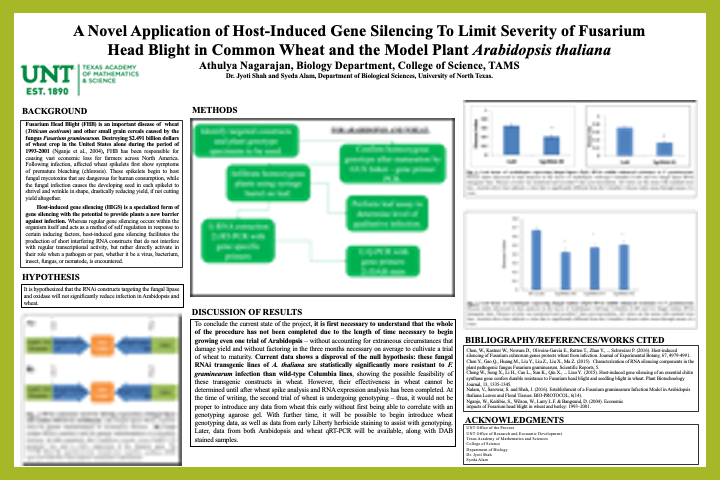First Name:
AthulyaLast Name:
NagarajanMentor:
Dr. Jyoti ShahAbstract:
Fusarium Head Blight (FHB) is an important disease of wheat (Triticum aestivum) and other small grain cereals, caused by the fungus Fusarium graminearum in North America, for which highly resistant varieties are not available, necessitating a need to identify and develop mechanisms to control this disease. Previous approaches to this problem have included fungicides and other systems - these typically fall short in effectively stemming fungal activity or become potential hazardous chemicals to humans and the environment. By using a novel approach which implements host-induced gene silencing methods (HIGS) as an extension of traditional RNA interference (RNAi) methods, we have succeeded in discovering the effectiveness of transgenic plants in preventing the spread of FHB in bread wheat. This was done by engineering specimens of the model plant Arabidopsis thaliana (thale cress) and wheat that employ HIGS methods - expressing recombinant constructs to produce small interfering RNA (siRNA) molecules that can silence expression of fungal genes required for pathogenicity when uptaken by the fungus. Chiefly, the Arabidopsis-F. graminearum pathosystem provided for trials in observing the efficacy of transgenic plants in curbing FHB infection spread. Two specific transgenic genotypes of transgenic plants were tested for this experiment - the first being a lipase gene previously shown to be required for fungal pathogenicity, and the other being an oxidase gene that is supposedly required by the fungus to limit the activation of plant defenses. In confirmation of our hypothesis, we discovered that the lipase and oxidase RNAi genotypes significantly outperformed the wild type in effectively controlling the spread and pathogenicity of FHB. The real-world applications of this breakthrough emphasize the necessity of a method of curbing F. graminearum and FHB in farms around the world. This novel HIGS method is more theoretically more beneficial to the plant, the environment, and humans in comparison to, say, fungicide or genetically modified species since it does not involve environmental contamination or intensive modification processes, with even dead tissue still containing RNA that can lead to a HIGS response. With global warming and lack of arable land beginning to hamper the growth and sustainability of the human population, innovations such as an effective method of hampering FHB will be necessary for farmers seeking to feed that burgeoning population.Poster:





